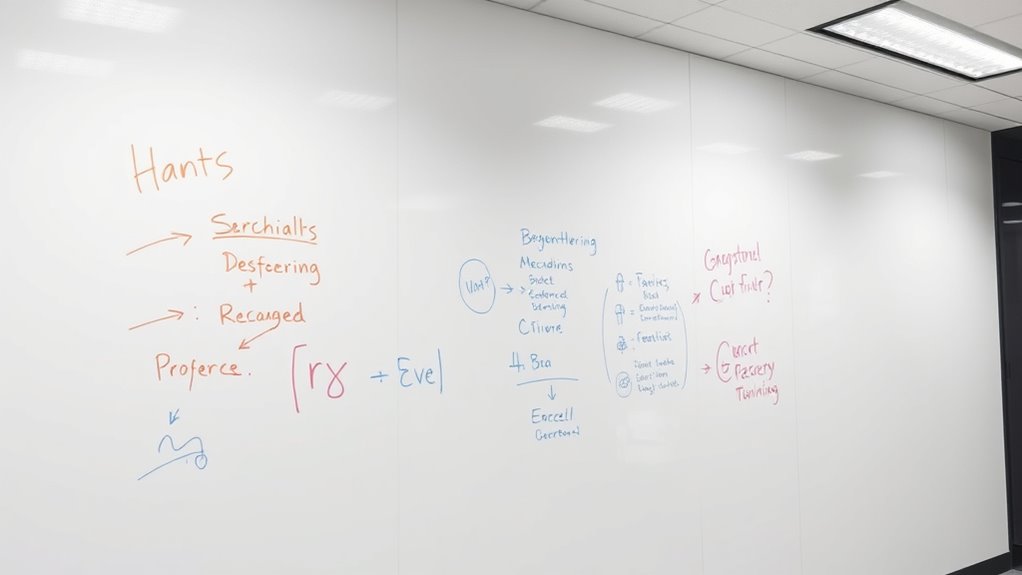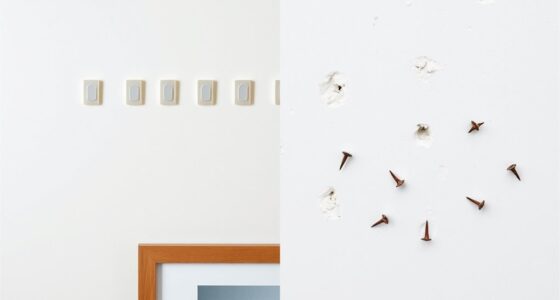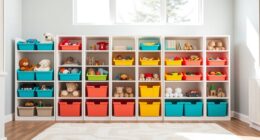To plan and maintain dry-erase paint walls, start by choosing smooth, clean surfaces like drywall or plaster and prep them properly to guarantee good adhesion. Apply multiple thin coats for durability and use painter’s tape for clean edges. To keep your wall responsive, clean it regularly with gentle solutions and avoid abrasive cleaners. If issues like dulling or peeling occur, light sanding and recoating can restore performance. Keeping up these steps helps your wall stay functional and engaging—there’s more to master in the process.
Key Takeaways
- Ensure the surface is smooth, clean, and non-porous before applying dry-erase paint for optimal adhesion.
- Use high-quality dry-erase paint with multiple thin coats for a durable, erasable finish.
- Mask edges with painter’s tape to achieve clean borders and a professional look.
- Regularly clean the wall with a soft cloth or eraser to prevent residue buildup and maintain responsiveness.
- Address dulling or ghosting by lightly sanding and applying additional coats of paint as needed.

Dry-erase paint walls transform ordinary surfaces into interactive, writable spaces, making them ideal for home offices, classrooms, or creative areas. When planning your project, it’s important to consider the interactive features you want to incorporate and the suitable surfaces for application. Not every wall or surface will work effectively with dry-erase paint, so evaluate whether your chosen surface is smooth, clean, and non-porous. Usually, drywall, plaster, or melamine surfaces are suitable, but textured or porous materials may cause the paint to peel or become difficult to write on. Before applying, ensure the surface is free from dust, grease, and previous paint layers that could interfere with adhesion. Proper preparation guarantees a smooth, durable finish that supports the interactive features you desire.
Once you’ve identified the suitable surface, prepare it thoroughly. Sand down any rough patches, clean off dust, and consider applying a primer if necessary. This step enhances adhesion and provides a uniform base for the dry-erase paint. When choosing your dry-erase paint, look for high-quality options that promise longevity and ease of cleaning. Remember, the surface you paint on will directly impact the effectiveness of the interactive features—clear lines, vibrant colors, and easy erasability depend on proper application. Use painter’s tape to mask off edges and create clean borders for a professional look. Applying multiple thin coats, rather than a single thick layer, will result in a smoother, more durable surface that stands up to frequent use. Additionally, selecting a paint with good adhesion properties can help prevent peeling over time.
Maintenance is equally important to keep your dry-erase wall in top condition. Regular cleaning with a soft cloth or eraser is necessary to prevent marker residue from building up, which can reduce erasability and interfere with the interactive features. Avoid abrasive cleaners or scrubbers that could damage the surface. For stubborn stains or ghosting, gentle solutions like a mixture of water and a small amount of rubbing alcohol work well. Over time, you may notice the surface becoming less responsive or dulling in appearance. When this happens, lightly sanding the surface and applying an additional coat of paint can restore its functionality. Proper maintenance extends the lifespan of your dry-erase wall, ensuring it remains an engaging and functional space for brainstorming, planning, or teaching.
Frequently Asked Questions
Can Dry-Erase Paint Walls Be Used Outdoors?
Yes, you can use dry-erase paint walls outdoors, but you need to contemplate outdoor durability and weather resistance. Choose a high-quality, weather-resistant dry-erase paint specifically designed for exterior surfaces. Keep in mind that exposure to rain, sunlight, and temperature changes can affect the writing surface. Regular maintenance, such as cleaning and resealing, helps maintain its effectiveness and longevity in outdoor environments.
What Is the Best Cleaning Solution for Dry-Erase Paint Walls?
Think of your dry-erase paint wall as a chalkboard needing gentle care. Use dry erase markers to test cleaning, then opt for a soft cloth dampened with mild cleaning agents like diluted isopropyl alcohol or a gentle glass cleaner. Avoid harsh chemicals, as they can damage the surface. Regularly wiping with these solutions keeps your wall clear, vibrant, and ready for your next masterpiece.
How Long Does Dry-Erase Paint Last Before Repainting?
Dry-erase paint typically lasts around 3 to 5 years before you need to contemplate repainting, depending on dry erase durability and surface longevity. To maximize its lifespan, clean the surface regularly and avoid harsh chemicals. Keep in mind that frequent use and improper cleaning can reduce its effectiveness over time. When signs of wear appear, such as ghosting or reduced erasability, it’s time to repaint to maintain a smooth, functional surface.
Are Dry-Erase Paint Walls Suitable for High-Traffic Areas?
Dry-erase paint walls can handle high-traffic areas, but you should consider durability concerns. Proper surface preparation is vital to guarantee the paint adheres well and resists wear. Regular cleaning and touch-ups help maintain the surface’s integrity. While they’re suitable for busy spaces, expect some signs of use over time, and plan for occasional repainting to keep the surface looking fresh and functional.
Can Dry-Erase Paint Be Applied Over Existing Wall Finishes?
You can apply dry-erase paint over existing wall finishes, but only if you carefully consider adhesion and surface prep. Did you know that improper surface preparation can reduce dry-erase effectiveness by up to 50%? Make sure your wall is clean, smooth, and compatible with the paint’s adhesive qualities. Proper wall surface preparation guarantees a smooth, durable finish, making your dry-erase wall a reliable, long-lasting surface for ideas and collaboration.
Conclusion
Transforming your walls with dry-erase paint is like giving your space a blank canvas, ready for your ideas and creativity to flow freely. With proper planning and regular maintenance, your walls become a dynamic masterpiece, constantly evolving and inspiring. Think of it as turning your room into a living, breathing chalkboard that invites innovation at every turn. Embrace this vibrant change, and watch your walls become the heartbeat of your imagination.








